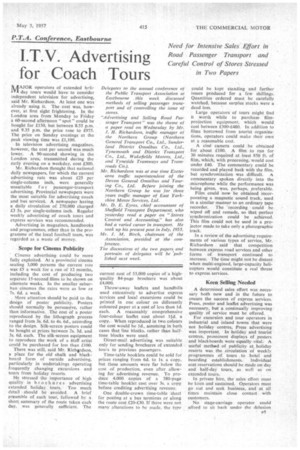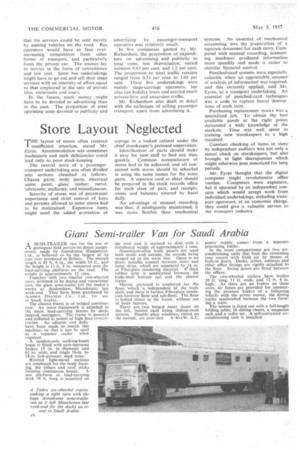P.T.A. Conference, Eastbourne
Page 95

Page 96

If you've noticed an error in this article please click here to report it so we can fix it.
I.T.V. Advertising
for Coach Tours
Need for Intensive SalesEffort in Road Passenger Transport and Careful Control of Stores Stressed in Two Papers IXAAJOR operators of extended holiIV' day tours would have to consider independent television for advertising, said Mr. Richardson. At least one was already using it. The cost was, however, at first sight frightening. In the London area from Monday to Friday a 60-second afternoon " spot " could be bought for £150, but between 8.55 p.m. and 9.35 p.m. the price rose to £975. The price on Sunday evenings at the peak viewing time was £1,100.
In television advertising magazines, however, the cost per second was much lower. A 90-second showing in the London area, transmitted during the early evening on a weekday, cost £300.
Mr. Richardson thought that national daily newspapers, for which the current advertising rate was about £25 per single-column inch, were generally unsuitable f o r passenger-transport advertising. Provincial newspapers were the most suitable for advertising coach and bus service. A newspaper having a daily circulation of 270,000 charged £3 5s. per single-column inch. Regular weekly advertising of coach tours and express services was recommended.
Advertising in magazines, handbooks and programmes, other than in the programme of the local football team, was regarded as a waste of money.
Scope for Cinema Publicity Cinema advertising could be more fully exploited. At a provincial cinema seating 3,000 persons the current rate was £5 a week for a run of 12 months, including the cost of producing two separate 15-second films to be shown on alternate weeks. In the smaller suburban cinemas the rates were as low as 7s. 6d. a week.
More attention should be paid to the design of poster publicity. Posters should normally be persuasive, rather than informative. The cost of a poster reproduced by the lithograph process ranged from.3s. 6d. to 4s. 6d., according to the design. Silk-screen posters could he bought at prices between 2s. 3d. and 35. 6d. each. The silk-screen equipment to reproduce the work of a staff artist could be purchased for less than £100.
There was still, said Mr. Rich.rdson, a place for the old chalk and blackboard form of outside advertising, particularly in undertakings operating frequently changing excursions and tours from holiday resorts.
He stressed the importance of high quality in b rochures advertising extended holiday tours. Too much detail should be avoided. A brief preamble of each tour, followed by a short summary of the route taken each day, was generally sufficient. The current cost of 55,000 copies of a highquality 84-page brochure was about £4,000.
Throw-away leaflets and handbills used extensively to advertise express services and local excursions could be printed in one colour on differently coloured paper at a cost of less than Id. each. A reasonably comprehensive four-colour leaflet cost about 14d. a copy. When reproduced in two colours the cost would be Id., assuming in both cases that line blocks, rather than halftone blocks were used.
Direct-mail advertising was suitable only for sending brochures of extended tours to previous passengers.
Time-table booklets could be sold for prices ranging from 6d. to Is, a copy, but these amounts were far below the cost of production, even after allowing for advertising revenue., To produce 4,000 copies of a 380-page time-table booklet cost over 3s. a copy before crediting advertising revenue.
One double-crown time-table sheet for posting at a bus terminus or along the route cost £20-130. if there were not many alterations to he made, the type , could be kept standing and further issues produced for a few shillings. Quantities ordered must be carefully watched, because surplus stocks were a dead loss.
Large operators of tours might find it worth while to purchase filmprojection equipment, which would cost between £300-£40.0. In addition to films borrowed from tourist organizations, operators could make their own at a reasonable cost.
A eine camera could be obtained for about £100. A film to run for 30 minutes required at least 850 ft. of film, which, with processing, would cost under £40. The commentary could be recorded and played back with the film, but synchronization was difficult. A commentary spoken directly into the microphone while the performance was being given, was, perhaps, preferable.
Film could now be obtained incorporating a magnetic sound track, used in a similar manner to an ordinary tape
recorder. The 'recording could be wiped off and remade, so that perfect synchronization could be achieved. This film could not be used in a projector made to take only a photographic track.
In a review of the advertising requirements of various types of service, Mr. Richardson said that competition between express road services and other forms of transport continued to increase. The time might not be distant when multi-engined, large-capacity helicopters would constitute a real threat to express services.
Keen Selling Needed A determined sales effort was necessary both now and in the future to ensure the success of express services. Press, poster and leaflet advertising was necessary, but a continually improving quality of service must be offered.
For excursion and tour operators in industrial and inland towns that were not holiday centres, Press advertising was important. In holiday and tourist centres, prominent displays of posters and blackboards were equally vital. A useful method of publicity at holiday resorts was the circulation of weekly programmes of tours to hotel and boarding establishments. Individual seat reservations should be made on day and half-day tours, as well as on extended tours.
In private hire, the sales effort must be keen and sustained. Operators must go out and seek business, and at all times maintain close contact with customers.
No stage-carriage operator could afford to sit hack under the delusion
that his services could be sold merely by putting Vehicles on the road. Bus operators would have to face everincreasing competition from other forms of transport, and particularly from the private car. The answer lay in service in the form of convenience and low cost. Soon bus undertakings might have to go out and sell their stage services with an intensity of effort equal to that employed in the sale of private hire, excursions and tours.
In the future, more money , might have to be devoted to advertising than in the past. The proportion of total operating costs devoted to publicity and advertising by passenger-transport operators was relatively small.
In five companies quoted by Mr. Richardson, the proportion of expenditure on advertising and publicity to total costs, less depreciation, varied between 0.63 per cent. and 1.2 per cent. The proportion to total traffic receipts ranged from 0.51 per cent. to 1.03 per cent. These five undertakings were mainly stage-carriage operators, but also ran holiday tours and carried much private-hire and excursion traffic.
Mr. Richardson also dealt in detail with the technique of selling passenger transport. apart from advertising it.












































































































































































































































